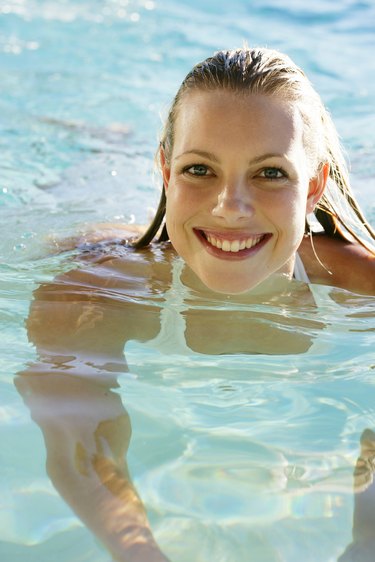
Swimming pool stabilizer, which is cyanuric acid, prevents chlorine from dissipating too quickly in an outdoor swimming pool. At optimal levels, this stabilizer or conditioner allows the pool owner to use less chlorine by preventing its destruction due to the sun's ultraviolet rays. Pool owners who use stabilized chlorine must be aware that this product will raise cyanuric acid levels in the pool, to a point that the acid is no longer effective.
Effects Of Ultraviolet Rays
Video of the Day
Ultraviolet rays from the sun destroy chlorine in the swimming pool water and this process is exaggerated during the long and warm days of summer. The use of cyanuric acid prevents chlorine from being destroyed by sunlight by forming a weak bond with any free chlorine in the water. Cyanuric acid also reduces the amount of chlorine that is required to rid the pool of algae build up.
Video of the Day
Amount Required
Your stabilizer should ideally be maintained below 100 parts per million (ppm). Keep it within the 40 to 80 parts per million range, as excessive stabilizer causes cloudy water and interferes with the action of the chlorine. In colder climates, a range of 20 to 40 ppm stabilizer is adequate. Levels from 80 to 150 ppm are excessive, but will yet begin to cause problems. The levels of cyanuric acid are lowered by draining the original water and replacing it with new water.
Stabilized Chlorine
Stabilized chlorine contains cyanuric acid, which adds to the amount of stabilizer that is already in the water. For this reason, it is not advised to use sodium dichlor to shock treat swimming pool water when a stabilized chlorine is being used, because this product will add to the already high cyanuric acid content. In these swimming pools, calcium hypochlorite, lithium hypochlorite or potassium hypochlorite can be used as a substitute for sodium dichlor.
Testing
It is important to know the level of cyanuric acid in the swimming pool. Pool companies will test this level for you, but you can also perform this test yourself, using a cost-effective dip-and-read test kit for cyanuric acid. Once the stabilizer level approaches 100 parts per million, the chlorine becomes progressively less effective. The swimming pool will become more susceptible to algae and will become cloudy. At this point, the water enters a state called "chlorine lock" and the swimming pool becomes cloudy and experiences recurring yellow-algae problems.